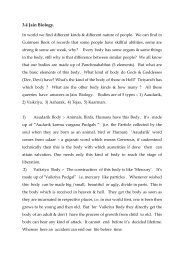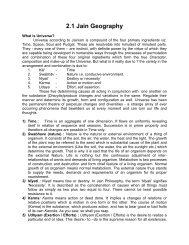âæ¢ ç¸ï¼¯ï¼ è£æ½® J - Jainism, Jain Religion - colleges
âæ¢ ç¸ï¼¯ï¼ è£æ½® J - Jainism, Jain Religion - colleges
âæ¢ ç¸ï¼¯ï¼ è£æ½® J - Jainism, Jain Religion - colleges
Create successful ePaper yourself
Turn your PDF publications into a flip-book with our unique Google optimized e-Paper software.
APPENDIX 2<br />
THE BASIS OF BECOMING A TIRTHANKAR: THE TWENTY AUSPICIOUS PRACTICES<br />
To reach the status of a Tirthankar it is not enough to do certain practices during certain birth. It is the result of a progressive<br />
process of unveiling the potential energy through endeavors in right direction during a series of incarnations. At what point<br />
this pursuit started and how it progressed, is detailed in the scriptures. It seems that the chief disciples or gods must have<br />
expressed their curiosity about the journey towards ultimate purity and the Tirthankars must have provided the details. That<br />
is why details of earlier births of all Tirthankars are available.<br />
The counting of these births<br />
„±üü<br />
starts from the birth<br />
¿¢¢Ý¢²<br />
in which the soul gets the<br />
½±¼é<br />
first glimpse of righteousness.<br />
J<br />
This is considered<br />
to be the most important turning point for a soul because once the right direction is attained, liberation is certain.<br />
The Earning of Tirthankar-nam-karma<br />
The loftiest of the pious category of Karmas is said to be the Tirthankar-nam-karma. It is important to know when and how it<br />
is acquired because this is the basis over which the status of Tirthankar is founded. This Karma is acquired one birth earlier.<br />
It is the physical or normal human body that acquires this Karma. The aural alternate body (Vaikriya Sharir) does not have the<br />
capacity to acquire this Karma. The future Tirthankar descends from the dimension of gods or ascends from the dimension<br />
of hell. In both these dimensions the souls have aural bodies. As the aural body does not have the capacity for long-term<br />
spiritual practices, this Karma is not acquired during this immediately preceding birth. That is the reason that all the Tirthankars<br />
do their final spiritual practices of acquiring this Karma during their last but second birth as human beings. During that birth<br />
they acquire a high degree of purity of perception. They become Kshyak Samyaktvi (the level of purity where the past Karmas<br />
are destroyed not suppressed).<br />
The acharyas say that the goal of spiritual pursuit should not be the status of a Tirthankar. Though its status is very high the<br />
Tirthankar-nam type of Karma is still a Karma and as such a tie. On the path of purity an effort to earn pious Karma is not<br />
advisable. The spiritualists never indulge in any activity that leads to bondage, irrespective of its being pious.<br />
All activities by spiritualists are directed toward shedding of the Karmas. As a result of certain activities or practices certain<br />
Karmas are wiped and as a consequence this specific bondage is achieved without striving for it. These practices are<br />
numbered twenty. These are also known as the twenty practices leading to the Tirthankar status and are believed to be the<br />
fundamental guiding factors for attaining the status of Tirthankar. These are:<br />
jainuniversity.org<br />
1. Worship of the Arihant (Tirthankar).<br />
2. Worship of the Siddha (liberated soul).<br />
3. Faith in the discourses.<br />
4. Worship of the teacher.<br />
5. Worship of the senior ascetic.<br />
6. Worship of the scholar.<br />
7. Worship of these who indulge in penance.<br />
8. Continued application of knowledge for maximum possible time.<br />
9. Purity of perception.<br />
10. To praise the virtues of others and be happy at the progress of others.<br />
11. To practice the six essentials including Pratikraman (self-analysis) in the prescribed way and at the prescribed time.<br />
12. Observe all the vows and codes of conducts with ever increasing indulgence.<br />
13. Detachment-always practice apathy for attachment, fondness, conceit, and greed. Develop the attitude of being detached.<br />
14. To activate the potential or to practice penance with all intensity.<br />
15. To give due importance and respect to the four pronged religious organizations.<br />
16. To look after and take care of the detached.<br />
17. To enhance knowledge regularly.<br />
18. To have faith on the sermons of the detached.<br />
19. To give charity to the deserving.<br />
20. Devotion for Tirthankar’s sermons and the disciple of the order.<br />
Amar Muni - Tirthankar Charitra - Surana # 49<br />
www.jainuniversity.org
















